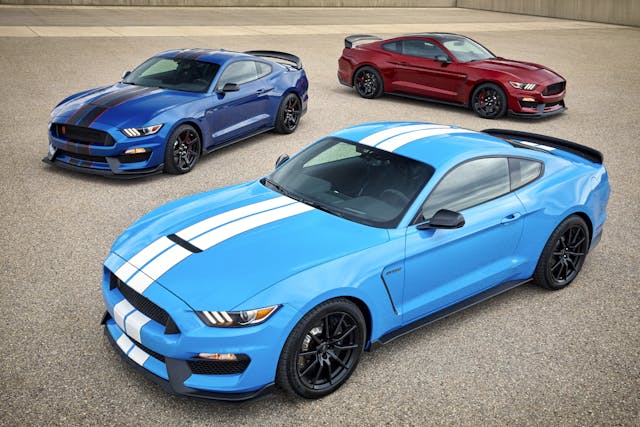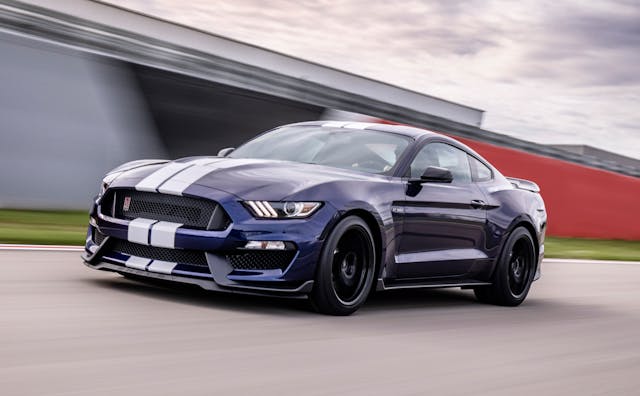Media | Articles
The modern GT350 is already on its way to becoming collectible
Almost lost in the big Mustang Mach E debut late last year was another Mustang milestone: The final S550-generation GT350 rolled off the assembly line. Introduced in 2015 to commemorate the 50th Anniversary of the original Shelby Mustang, the new-age GT350 is now itself history.
It’s also a surefire collectible, even as the Shelby Mustang with the highest production numbers in history (the 23,574 combined production run of the GT350 and GT350R just edges the 2007-2008 GT500s total of 22,989). Although the car is not yet part of our price guide, we do provide insurance for the cars, which means we can track values owners quote over time. No surprise, many are still depreciating (as we’ve reported before, even new supercars aren’t immune to the normal cycle of depreciation), but only slightly. Some are already on the upturn.
According to our insurance data, the flat-plane ‘Stang is extremely popular with the big fish in the collector hobby. The average GT350 owner for whom we provide insurance has 7.8 cars in their collection, and nearly half of all of them own at least three classics. (The average Hagerty member, for comparison, has one car).
No surprise that GT350 owners have a soft spot for American metal. Other Fords are most popular with these collectors, which tracks for American collectors who tend to be tribal when it comes to the Big Three and Ford in particular. Yet we also see a fair number of Porsches, which account for 5 percent of the cars in these owners collections, as well as Shelbys (4 percent).
As you might guess, a lot of GT350 owners collect Mustangs. In fact, 65 percent of the owners with three or more cars also own another Mustang. Original GT350s are, of course, quite pricey and thus aren’t commonplace in any collection. But if we zoom in on new GT350 owners with 10+ car collections, we find that 17 percent of them also have a 1965/66 example. A matching set would be enticing, indeed.
Marketplace
Buy and sell classics with confidence
Before we go further, let's state the obvious: Any modern GT350 is a special car worthy of the storied Shelby badge. Instead of relying on a beefed-up version of the Mustang GT’s Coyote V-8, the GT350 received a bespoke 5.2-liter mill with a Ferrari-esque flat-plane crank. Dubbed "Voodoo," the engine received (at the time) the highest horsepower rating—526—in the company’s illustrious history of building naturally-aspirated V-8s. Along with all of those ponies came a stratospheric 8250 redline.
A Torsen limited-slip differential was standard, along with Michelin rubber, sized 295 in front and 305 out back. The chassis and aero-kit also received comprehensive upgrades, including a stiffer suspension, a functional diffuser, and heavy-duty brakes. An optional Track Pack tacked on engine, transmission, and differential coolers, an aluminum strut-tower brace, and a more aggressive spoiler and magnetorheological dampers (the latter being a first on a Ford product). MagneRide also came as a part of the Tech Package that had a steel brace and threw in a bigger infotainment screen with SYNC 3 voice recognition, seven-speaker premium audio, and six-way power-adjustable front seats with heating and cooling.
Production kicked off with an extremely limited run of 100 GT350s—50 with the Track Pack and 50 with the Tech Pack. As a nod to the models Carroll Shelby took racing in 1965, Ford also minted 37 examples of the GT350R for 2015. Like its forebears, the R eschewed the rear seats in the name of weight savings. It also became the world’s first mass-produced vehicle with standard carbon-fiber wheels (saving 16 pounds at each corner). An even more hardcore rear wing and grippier Pilot Sport Cup 2 tires (now, 305 front, 315 rear) rounded out the changes for this track-focused trim.

Unsurprisingly, our insurance data pegs the limited-run 2015 as the most valuable year for the modern GT350. After holding steady around $80,000 between 2017 and 2019, the base 2015 GT350 experienced a dip to $70,000 on average over the course of 2020. But whereas most of the other GT350 model years have continued along their expected depreciation curve, the 2015s have rebounded to an average of $73,000 so far this year. Those few GT350Rs built for the 2015 model year, meanwhile, have proven to be some of the best investments to come out of the American car industry in recent memory. Back in 2018, finding and attaining one of these rare beasts would have cost almost $100K over sticker with an average value of $162,500. Since then, the set of 37 cars has seen a 63 percent gain; they now trade for an astonishing $265,000.
Fortunately for enthusiasts on a tighter budget, Ford opened full-on GT350 production for the 2016 model year and, through the end of the line last fall, built 23,574 GT350s in total. Most of these have followed a depreciation curve more typical of a new car. The 2016s in particular are the most attainable, with a median insured value of $55,000 for a GT350 and $70,000 for a GT350R. The 2017–2018 models have depreciated slightly less (so far).
Model-year 2019 GT350s have, so far, held at their original sticker value of around $65,000 with options, or $69,000 for the R. That's likely a testament to how hot the used-car market is at present, but also to the fact that the '19s received several upgrades, including an optimized grille, redesigned rear spoiler (with optional “Gurney flap”), a redesigned Michelin Pilot Sport Cup 2 tire previously available only on higher trims, and damping and spring recalibration. The '19 GT350R carried on functionally unchanged, which probably explains why it has lost value relative to upgraded base cars built that same year.

The R did receive those same GT350 upgrades for its 2020 model year curtain call. Along with the chassis/suspension tweaks, it was treated to new solid brake rotors, which, it was said, were more durable than the setup on previous examples. As part of its send-off for the best modern Mustang, Ford offered a special Heritage Edition. All Heritage Editions featured a Ken Miles-at-Green-Valley-Raceway-mimicking pair of Guardsman Blue stripes, unique blue exterior badges, and throwback rocker panel stripes.
The last-of-the-breed 2020 models have actually appreciated since they were built just a short time ago. It's too soon to tell whether this will be an enduring trend or if they'll eventually depreciate, but their strong values out of the gate could reasonably chalked up to generous standard equipment, the benefit of Ford's continued GT350 refinement, and the mere fact that these are the last of a monumental model run.
All told, 20,063 (87.5 percent of the total build-out) belonged to the base GT350, while the GT350R rounded out the remaining 3511 units. When the floodgates were opened for 2016, 6169 Shelbys, spread out between 5643 GT350s and 526 GT350Rs, were built for the car’s sophomore campaign.
While all 2015s and Rs are exceedingly rare, collectors with a tighter budget can still sniff out some very hard-to-find 2016s. When the three “Over the Top” stripe options from each trim level are included, some unique builds stand out from the rest. Of the 5,643 GT350s built in ’16, 4,300 were optioned with stripes, making non-stripe cars pretty scarce. The most popular stripe color was black, with 1691 orders. white stripes were placed on 1007, and blue stripes made their way onto 1,602 cars. A whopping 1282 of the cars with blue stripes were Oxford White, so any non-white 350 with blue stripes is more of a unicorn than a Mustang. The rarest of the rare features blue-stripes over a field of Race Red. Just six cars wear this combination.

2017 GT350s and GT350Rs have almost exactly mirrored values of the 2016 models, albeit slightly more valuable given the ‘16s have a 12-month head start on depreciation. We insured base model ‘17s for an average of $65,000 in 2018, and that number has fallen almost $10,000 to just over $56,000 in 2021. A 2017 R commands around $71,000 these days, barely besting the 2016 after kicking off their life-cycle as the only non-2015 data point on our graph to reach six figures.
Values for 2018 models have been hot on the heels of the previous two years. As it stands, ’18 owners have the most middle-of-the-road GT350 investment on their hands. Base cars have held steady at 60 grand for the past two trips around the sun, while the ’18 Rs line on our graph perfectly overlaps 2017’s line after starting off on top of the 2016’s.
The 2019 GT350 has been a beacon of stability, not budging an inch off of its original $65,000 insurance quote value in three years. The R has a similarly flat story to tell as it still sits precisely where it always has on our value chart. The ’19 R currently shows up as the second-least valuable of the lot (again, owing to the lack of updates compared to the standard GT350 that year) just ahead of 2016 but not far removed from the virtual tie in ’17 and ’18 values.

Base 2020 GT350s have actually appreciated since new. They are currently knocking on the door of a $68,000 average valuation after starting off life some 3.5 percent lower at $65,000. The only year of R production with the aforementioned upgrades has it solidly in second place behind the unobtanium ‘15s, but with an average insured number of $80,000, they are nowhere near as precious to collectors as the original 37. Not yet, anyway. In the long-term, expect the improvements and the highly desirable Heritage package to put the ’20 R on the fast track to serious collectible status.
Demographics of GT350 owners who get insurance from Hagerty suggest that older owners are moving on from their GT350s, and younger buyers are picking up the slack. Between 2018 and 2021, the share of Hagerty-insured GT350s owned by Baby Boomers dropped to 63 percent from 68 percent. Gen-X accounts for 27 percent of the owners, but a rising share of those calling us for a quote on one (meaning they've likely just purchased it or are about to). Millennials, generally a price-sensitive bunch, account for just 3 percent of GT350 owners but are calling us more frequently about them, rising from 16 percent in 2018 to 24 percent in 2021.
It will be interesting to continue to monitor the market for modern GT350s. It is an instant classic that already has its name firmly cemented in the pantheon of all-time great American cars. Wherever it goes from here, one thing is for certain; we hated to see it go, but we still love listening to it drive away.






